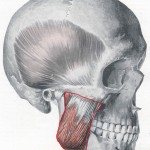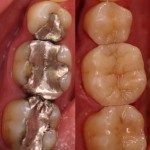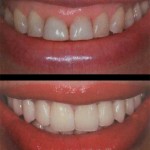Many people have missing side teeth. Most are not really bothered by this: what matters is that the front teeth – the window display – are in good condition!
This is a big mistake, since the side teeth are very important, they protect the jaw and the front teeth from excessive strain …
–
Missing side teeth can lead to headaches, jaw pain and even back pain due to overloading and overuse.
–
Here you can see a cross-section of a jaw with a complete set of teeth, and the masseter, one of many chewing muscles. The masseter is highlighted in red.
–
–
–
–
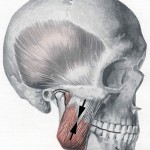 When this muscle contracts, the lower jaw in pressed against the upper jaw. The teeth touch at the occlusion surface and the lower jaw comes to a stop because of the side teeth.
When this muscle contracts, the lower jaw in pressed against the upper jaw. The teeth touch at the occlusion surface and the lower jaw comes to a stop because of the side teeth.
There is a definite gap between the jaw link head and socket.
–
–
–
–
By providing support, the side teeth protect the jaw from excessive chewing pressure. This mechanism is further reinforced as the side teeth touch before the front teeth do. The lower jaw rotates away from the joint, and the side teeth act as a hypomochlion (=angle point) and protect the jaw.
–
–
–
–
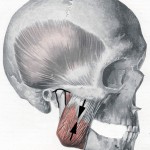 If the side teeth are missing, or the occlusion surface is decreased because of uneven teeth, then the masseter pushes the lower jaw more towards the base of the cranium, and the joint gap disappears. The jaw is overstrained, which in time can lead to slight pain or even necessitate operations on the jaw.
If the side teeth are missing, or the occlusion surface is decreased because of uneven teeth, then the masseter pushes the lower jaw more towards the base of the cranium, and the joint gap disappears. The jaw is overstrained, which in time can lead to slight pain or even necessitate operations on the jaw.
–
It is therefore crucial to replace teeth, not only front teeth for aesthetic purposes, but also side teeth! Replacing side teeth keeps you healthy. Moreover, front teeth tend to be overused if there are not enough side teeth, which makes bone recede and eventually leads to loss of front teeth! –
–
A partial denture can be used to replace side teeth, implants are not always necessary – the main thing is that you can chew on the side!
–
Source: 2009_Side teeth

